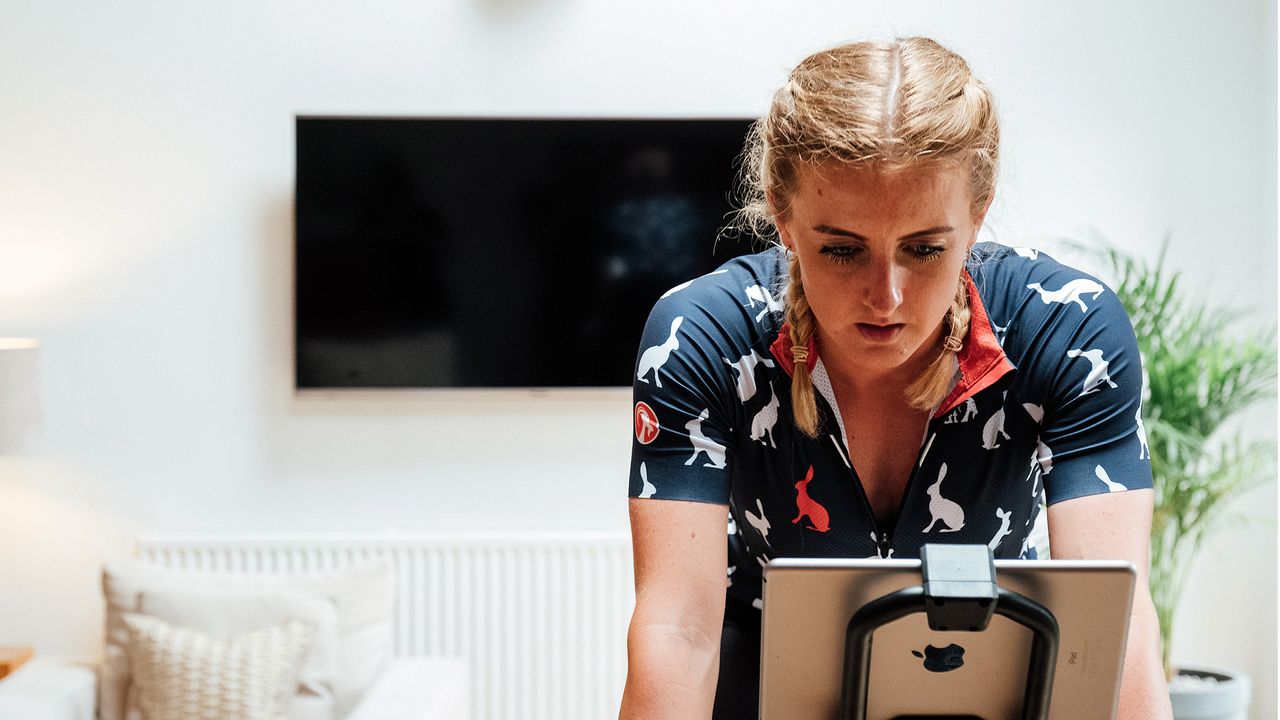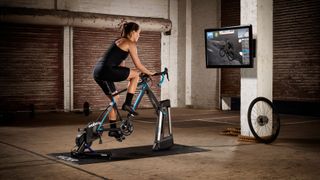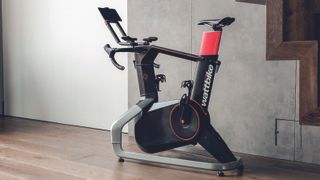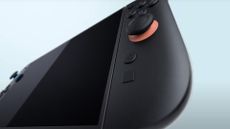
Everyone with an interest in cycling wants to get faster on the bike, whether that’s to grab Strava KOMs, get fit for a sportive or shave some time off your ride to work. However, even for those with next to no interest in road or trail cycling, indoor cycling (at home rather than at the gym – well, most things are at home these days, let's face it) can be extremely useful exercise. It's great for weight loss, cardio fitness and all-round well being.
But what’s the best way to get yourself in shape with indoor cycle training? Read on…
- Advanced studies: Sportive training at home
- How to get fit fast at home with indoor cycling
- Best Zwift setup for every budget!
In short, take your training indoors. While nothing beats the feeling of crushing your local climb or descending with the wind in your face, if you want to pedal like a pro, indoor training is the most efficient and effective way to get fit on two wheels.
“Anyone can benefit from indoor training, whether you’re new to cycling or an experienced racer,” says James Spragg of Spragg Cycle Coaching.
Let’s run through the benefits of indoor training and some of the workouts you can use to get fit.
What are the benefits of indoor cycling?
Indoor training is free from the distractions and external variables that come with riding on the road, including traffic, weather conditions and the suitability of your local terrain. There are no traffic lights to stop at, nor can you freewheel - indoor cycling sessions may only be short, but you’re making the most of every pedal stroke.
"You can constantly chip away at your fitness, even if you only have 30 or 60 minutes,” says Ian Jenner of Rule 5 Cycling Coaching, who advises complementing your weekend rides with two or three short, sharp indoor sessions.
Sign up to the T3 newsletter for smarter living straight to your inbox
Get all the latest news, reviews, deals and buying guides on gorgeous tech, home and active products from the T3 experts
What do you need to get started?

You can ride Zwift with a conventional turbo trainer, a smart turbo trainer or a dedicated indoor training bike
If you want to train on the bike from the comfort of your own home, you have two options. You can either mount your regular road bike on a turbo trainer, or you can use a dedicated indoor training bike like the Wattbike Atom.
These smart trainers are packed with the tech required to directly measure your power output. Paired with the latest training apps – Zwift, TrainerRoad and The Sufferfest being the most famous – they will also automatically control the resistance on their virtual race and training courses – ramping up the intensity when you hit a hill, for instance.
These smart training apps also provide tests to help you measure your baseline power, as well as a wide range of interval workouts to get the most out of every session. Zwift’s virtual worlds also let you ride alongside or against thousands of other cyclists.

You can also use these apps with a conventional turbo trainer, but you’ll normally need an ANT+ or Bluetooth speed sensor on your bike to communicate with your smartphone, tablet or computer. Conventional trainers can’t measure your power output directly or automatically control the resistance (you’ll need to use your bike’s gears for that), but they are significantly cheaper than smart trainers.
Indoor cycling workouts
Intervals (repeated periods of focussed exercise followed by periods of recovery) are the name of the game, as far as indoor cycling is concerned, and prompt your body into making the physiological adaptations required to get fit. You can tailor the intensity of the intervals to work on specific areas of fitness.
Training indoors also means you can get straight down to business, so you can truly make the most of every session. In fact, if you’re short on time, indoor cycling is your route to getting fit fast.
“You can perform every session exactly as planned,” adds Spragg. “There’s no need to waste time riding out to a specific stretch of road or a local climb.”
An interval workout will require you to judge your effort to ensure you’re working hard enough, without overdoing it or blowing up before the end of the session. It’s a tricky balance, so you can use Rate of Perceived Exertion (RPE), heart rate or power to help you.
Rate of Perceived Exertion (RPE)
RPE refers to a sliding scale to gauge the intensity of exercise. It’s the simplest way to judge whether you’re pedalling too hard or too easy, without needing additional gadgets to measure your heart rate or power output.
RPE is simply a measure of how hard you feel you are working, rated from one (sitting on the sofa doing nothing) to ten (100% sprint to the line). The higher the number, the less time your body will be able to remain at that intensity. British Cycling has the full RPE scale on its website.
Heart rate
A heart rate monitor adds an element of scientific data to your training. That means you can closely monitor your riding intensity in order to pace your efforts, as well as targeting heart rate ‘zones’ to achieve specific training benefits.
There are two types of heart rate monitor: a strap that fixes around your chest to measure your beats per minute as blood is pumped from your heart, or a watch that measure your pulse from your wrist. Generally the former is more reliable. Either way, using a heart rate monitor is the easiest and most affordable way to dive a little deeper into your training.
Power
Power meters are all the rage with experienced cyclists and measure the watts produced when you stamp on the pedals. Power is the most accurate and reliable measure of your performance and, if you’re serious about your training, allows you to closely target very specific physiological adaptations.
You can attach a power meter to your bike (crank, pedal and wheel-based units are available) but, for indoor cycling, the latest smart turbo trainers and interactive training bikes also come equipped with built-in power meters.
Polarised training explained
While sweet spot training has its benefits, the polarised training model has proven to yield even greater training adaptations by spending more time riding at lower intensities.
In fact, it suggests that up to 80 per cent of your time should be spent at a low intensity and 20 per cent at a high to severe intensity – no sweet-spot riding here. Coined by sports scientist Stephen Seiler, polarised training has been adopted by many elite and professional athletes and the results have been extraordinary.
1. Ride slower, ride solo
By riding slower not only will you benefit from sizeable aerobic gains without having tapped into your physical and emotional stores, you will also improve your ability to metabolise fat as an energy source and become more efficient as a result.
To achieve such gains, however, you may find yourself riding solo more often due to the inherent racing dynamics that often play out when participating in local group rides.
2. Less is more
You don’t have to spend 15-20 hours a week training like a pro to make significant performance gains. A big benefit of polarised training is that it can be tailored to suit a demanding schedule.
A recent study by Stephen Seiler demonstrated that athletes training three to five hour per week yielded greater results from a polarised approach than those focusing on threshold training.
3. Fat is fuel
Exercise intensity has the biggest impact on which source we derive our energy from – carbs or fats.The polarised training model focuses around spending the majority of your time riding at a low to moderate intensity, which promotes fat metabolism.
4. Raise your VO2 max
The polarised training model has shown to increase both your stroke volume and your ability to burn oxygen, which comes from exercising at a higher intensity (zone 5). These sessions improve VO2 max, lactate threshold and peak power output.
5. No pain, no gain
Minimal time is spent training in zones 4 and 5 but this is where the most significant performance gains made. Limited to one or two sessions per week in the form of intervals, these sessions are exceptionally hard but maximise your body’s ability to deal with pain, which results in improved performance.
• This article is part of a series on indoor cycling, supported by Wattbike
-
 There's one Nintendo Switch 2 feature that'll make it a massive upgrade, and it's not the screen
There's one Nintendo Switch 2 feature that'll make it a massive upgrade, and it's not the screenSay goodbye to Joy-Con drift forever
By Rik Henderson Published
-
 GTA 6 could be the game of 2025, but it's rumoured price will make you spit out your coffee
GTA 6 could be the game of 2025, but it's rumoured price will make you spit out your coffeeYou'd better be sitting down when you read this...
By Rik Henderson Published
